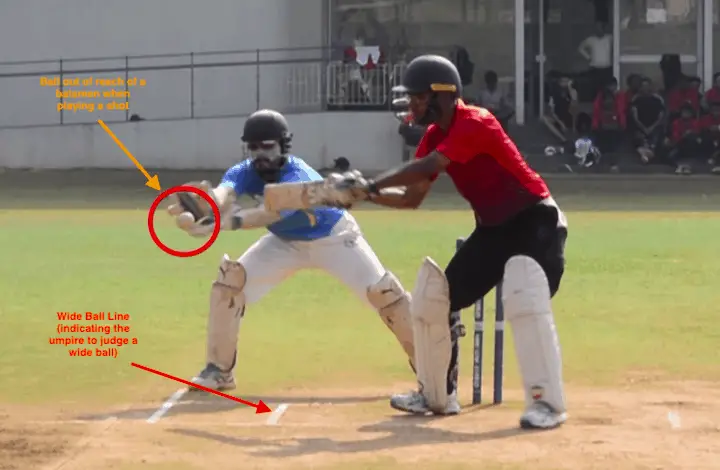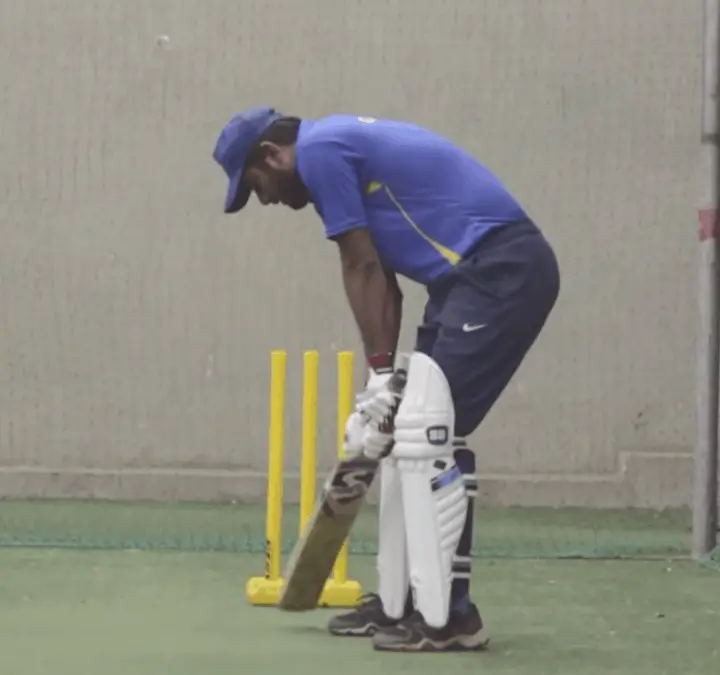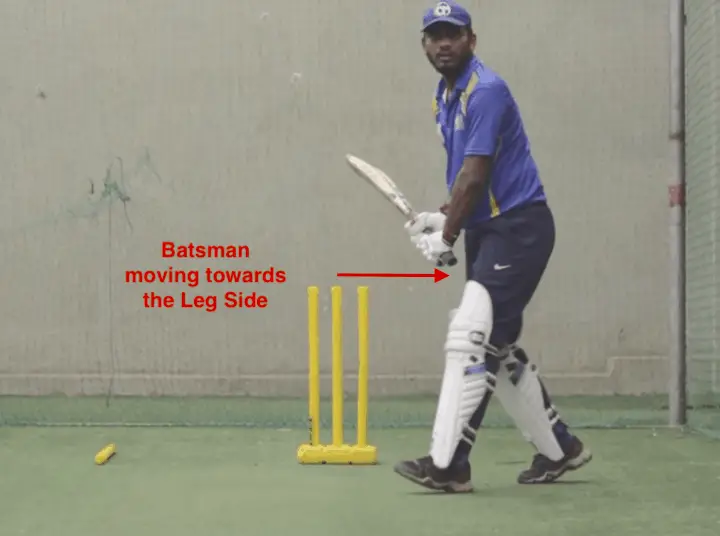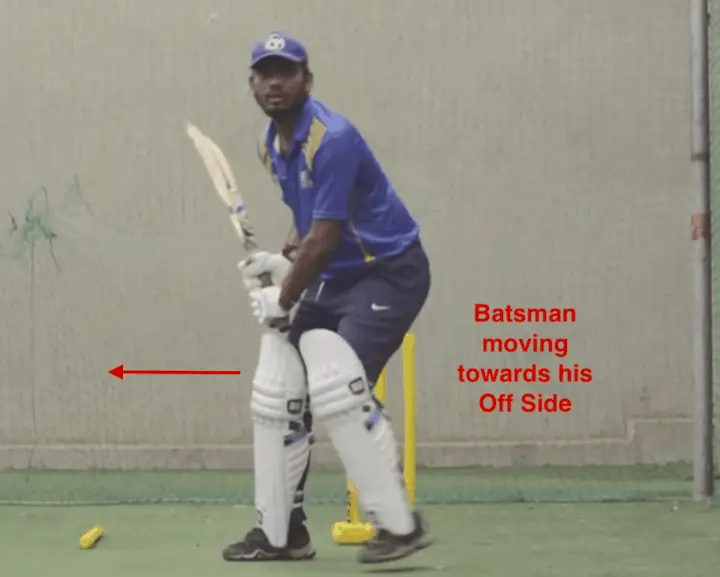If you’re starting out new in the Game of Cricket, you might often be confused when is a “Wide Ball” given. After all, there are several rules around it! So, it is easy to get confused about it. But don’t worry, in this article, we tell you everything there is to know about a “Wide Ball” in cricket.
But first, what is a wide ball in cricket? A wide ball occurs in cricket when a delivery bowled by a bowler is not within the reach of the batsman batting in a normal guard position. This also applies to bouncers or deliveries over the head of the batsman that are not within his reach.
While the definition may look simple, if not understood correctly, it can become complicated quite quickly. For instance, how does an umpire judge whether the delivery is within reach of a batsmen? Or what happens when the batsman moves from this normal guard position?
Let’s look at all these scenarios and more in detail below –
What Exactly does the Wide Ball Rule say?
Law 22 of the Laws of Cricket are responsible for the definition of the Wide Ball.
According to the Law 21.1.1, “If the bowler bowls a ball, not being a No ball, the umpire shall adjudge it a Wide if, according to the definition in 22.1.2, the ball passes wide of where the striker is standing and which also would have passed wide of the striker standing in a normal guard position.”
Law 21.1.2 states that “The ball will be considered as passing wide of the striker unless it is sufficiently within reach for him/her to be able to hit it with the bat by means of a normal cricket stroke.”
So, How to Judge a Wide Ball in Cricket?
The laws stated above can get technical for some quite quickly. But, the easier way to understand how to judge a Wide Ball is this –

Firstly, a wide ball is relative to the position of the batsman and not the position of the wickets.
If the batsman is batting in a normal guard position, an easier way to judge a wide ball is when the ball passes wide of the Wide Ball line (check the image showcased above).
A normal guard position means that a batsman has not moved on either side of the wicket while the delivery is being bowled by the bowler and he has batting on a middle or middle-leg stump guard (as indicated in the below image).


The above images indicate a normal guard position of a batsman.
However, if the batsman moves from his batting guard while the bowl is being delivered, then based on the movement of the batsman, the umpire may make the decision accordingly.
Wide Ball Application when Batsman moves towards the Leg Side

If the batsman moves towards his leg side, then –
- It WILL be a wide ball if the ball delivered is even wider than the wide ball line outside the off-stump despite the batsman moving towards his leg side.
- It will NOT be a wide ball if the ball delivered is within the wide line outside the off-stump despite the batsman moving towards his leg side.
If, however, the ball is bowled wide on the leg stump when the batsman is also moving on the leg side (also known as the bowler following the batsman) –
- It WILL be a wide ball if the ball bowled by the bowler is wider than the movement of the batsman and it completely misses the legs of even the batsman.
- It will NOT be a wide ball if the ball bowled is either between the legs of the batsman or between the wickets and batsman. In such a scenario, even if the ball goes beyond the wide line but doesn’t go beyond the legs of the batsman, the delivery will not be call a wide ball.
Wide Ball Application when Batsman moves towards the Off Side

If the movement of the batsman is towards the off side of the stumps rather than the leg side, then –
- It will NOT be a wide even if the ball is outside the off stump wide line but within the reach of the batsman. Similarly, it will not be a wide ball if the delivery is within the wide line on the leg side.
- However, it WILL be called a wide if the ball is outside the reach of the batsman on the off side even if the batsman has moved towards the off side. The delivery will also be called a wide ball if it is outside the wide line on the leg side even though the batsman has moved towards his offside while the ball is being delivered.
Over the Head Wide Ball
The delivery can be considered a Wide Ball not just when it is bowled wide outside the off stump or the leg stump. It can also be ruled a wide ball when the bowler tries to ball a bounder (a short-pitched delivery) and the ball bounces much higher than the batsman’s head such that it is out of the reach of a batsman.
Difference between Over the Head Wide Ball and a No Ball
The difference between an over the head wide ball and a no ball can be determined from the height at which the ball passes the batsman. When the ball is around the head of the batsman, it is a no ball. However, when the ball is out of reach of the batsman over his head, it is considered a wide ball.
What is the distance of the Wide Ball line marking in Cricket?

The distance of the wide ball line, when marked from the middle stump, is 0.89 meters or 35 inches or approximately 3 feet in length on both sides of the stumps.
In test matches, the wide line is considered as the 0.89 meters on the leg side. However, the wide line on the leg side changes to a much shorter length in ODI cricket and T20 matches. This is done so in order to negate the “negative” bowling by bowlers. The wide line rule in ODI and T20 match is implemented with more strictness than in Test Matches.
When is it Not a Wide Ball? (Exceptions to the Rule)
If judging a wide delivery hard enough, there are exceptions to the rule. The exceptions on when a delivery is not considered a wide are quite simple.
A delivery is NOT considered a wide ball when –
- The delivery while passing the batsman either touches the bat, pad or any other part of the batsman (even if it may seem a wide ball otherwise).
- The delivery, even though, seems to be wide but doesn’t even reach the batsman. In such a scenario, it shall be called a dead ball.
- The delivery seems to be sufficiently within reach of the batsman when he/she moves while the bowl is being delivered.
- The delivery bowled by the bowler is within the wide lines.
Runs resulting from a Wide Ball (including the penalty runs)
As per the rules of cricket, a bowling team is penalised 1 run when bowling a wide ball. This 1 run is awarded to the batting team.
Furthermore, if a boundary is scored on a wide ball, a total of 5 runs (4 runs from a boundary and 1 run penalty) are awarded to the batting team.
Additionally, when a wide ball is called, the ball does not become dead. This means, the two batsman can decide to score additional runs by running between the wickets if they see an opportunity to do so.
All the runs scored on a wide ball are awarded to the batting team and not to an individual player.
The wide ball itself is not counted as a legal delivery. This means that even though the runs are scored by the batting team, the ball doesn’t count as a legitimate delivery of a 6-ball over. The bowler has to bowl 1 additional delivery for every wide ball bowled.
Can a Batsman get Out on a Wide Ball?
Yes, a batsman can be given out on a wide ball in only the four following ways –
- Stumped
- Run Out
- Hit Wicket
- Obstructing the Field
If a batsman is outside the popping crease and the bowler decides to bowl a wide, and the wicketkeeper disturbs the wickets before the batsman can get back in the crease, the batsman can be deemed as Stumped Out.
Likewise, if any of the two batsmen are unable to reach their respective crease while trying to take a run on a wide ball, and the stumps are disturbed by the fielding team, the batsman can be deemed as Run Out.
In such a scenario, when a batsman is given out on a wide ball, all the penalty runs shall still be awarded to the batting team and such a delivered shall be considered a legal delivery.
Related Question –
Q. What is a Bowler bowls a Wide Ball and a Front Foot No Ball?
If a bowlers bowls both a wide ball and a no ball, the preference is given to the no ball over the wide ball. Thus, in such a scenario, the no ball shall overrule the wide ball.
